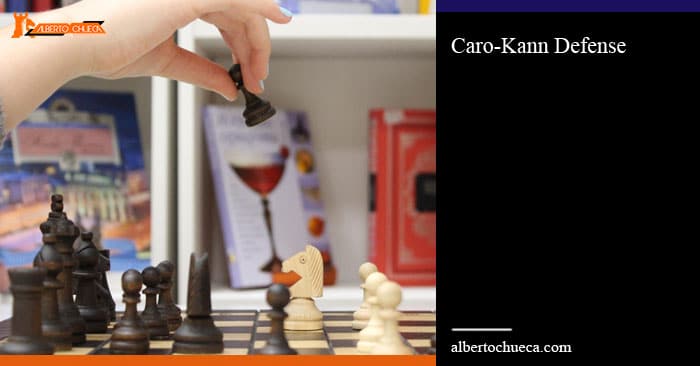Table of Contents
Caro-Kann Defense
Hi everyone. In this post, we are going to analyze and learn how to play the famous and strong Caro-Kann Defense. According to my database, this variation is the fourth most common move Black can reply against King’s Pawn (only Double King’s Pawn, Sicilian and French are more frequently played).
1.e4 c6
It is important to understand the first move Black plays 1. … c6. Ok, they want to fight for the center and play d5, that is clear, but you might be wondering why with c6? That move is not developing (unlike 1. … e6, which clears the line to develop the dark squares Bishop). Indeed, a big problem in French Defense is this pawn on e6, which is blocking the light squares Bishop. That does not happen in Caro-Kann, and this Bishop can be developed outside of the chain of pawns (see Classical or Advance Variation below). The drawback, as we said, is the development.
Why is Caro-Kann a good choice?
This defense has a well-deserved reputation of being very solid. So, if you do not like open, sharp positions, this is the kind of openings you should learn.
Also, every chess player who wants to continue improving should learn different openings according to what he or she is looking for in one particular game. Because when we need to win as Black, it is very well to use aggressive defenses like Sicilian or Scandinavian. But sometimes we do not need to win maybe because a draw is fine to get the victory in a tournament or a match, or just because your opponent is fantastic in sharp positions. In those situations, it is ok to avoid too complicated middlegames, and knowing a solid variation like Caro-Kann is going to be so useful.
Some theory and ideas
1.e4 c6 2.d4 d5
In this position, Black is threatening the pawn on e4. White has three main options:
-
Advance Variation
3.e5 Bf5 4.Nf3 e6 5.Be2 c5 (Nd7 or Ne7 are also fine) White will be very slightly better
-
Exchange Variation
3.exd5 cxd5
And here there are some options, but probably the mainline White can play is Panov Attack
4.c4 Nf6 5.Nc3 e6 6.Nf3 Bb4 7.cxd5 Nxd5 White is very slightly better
In this line, the first player could have a typical Isolated Queen Pawn on d4.
-
Protect with the Knight
3.Nc3 (or Nd2, which in general is transposing to the same line after the next trade) dxe4 4.Nxe4 Bf5 (and here we are in Classical Variation)
5.Ng3 Bg6 6.h4 h6 7.Nf3 Nd7 The advantage is minimal for White
Instead of 4. … Bf5 there is another interesting option for Black:
- … Nd7!? Which is Modern Variation in Caro-Kann Defense
It is also very playable, but in this line, there is a funny trick I want to mention. If your opponent plays 5.Qe2, please, do not play Ngf6??, because then White would be winning. Do you want a clue? There is mate in one:
6.Nd6!! # :)
Typical Pawn Structures in Caro-Kann Defense
-
Blocked Center (Advance Variation)
White: a2 b2 c2 d4 e5 f2 g2 h2
Black: a7 b7 c6 d5 e6 f7 g7 h7
The first player has a small space advantage. As the center is blocked, the plan is to play in the wings. Black should break on c5, or at least on f6 at some point, to fight against the white strong chain of pawns.
-
Isolated Queen Pawn (Panov Attack)
White: a2 b2 d4 f2 g2 h2
Black: a7 b7 e6 f7 g7 h7
This pawn structure is analyzed in the article about Queen’s Gambit.
-
Classical Variation Structure
White: a2, b2, c2, d4, f2, g2, h2
Black: a7, b7, c6, e6, f7, g7, h7
This pawn structure is exactly the same we studied in the analysis of Scandinavian Defense; it also appears very often in that dynamic variation.
Typical Plans for Black in Caro-Kann Defense
-
Advance Variation
The center is blocked; Black needs to play in the queenside. Very often they break on c5, to fight for the center and space. It could be a little difficult for the second player to develop the pieces in the kingside because the Knight and the dark squares Bishop are colliding on e7, so Black can bring the Knight out quickly planning the path e7-g6, e7-f5 or e7-c6. Also, the Knight can go h6-f5 in this line of Caro-Kann Defense.
.
-
Exchange Variation (Panov Attack)
The idea in this line is very much related to the pawn structure. White will have an Isolated Queen Pawn, so both sides should play using the typical plans for these positions. In general, Black wants to trade pieces, and block and attack the isolated pawn.
-
Classical Variation
Black pieces are developed more or less easily. Then, they can decide whether to castle queenside, planning a long game with maneuvers from both sides or to castle kingside, with a very sharp middlegame because of the opposite side castlings.
Typical squares for some black pieces in Caro-Kann Defense
-
Advance Variation
King: Usually Black castles kingside.
Bishops: Light squares Bishop goes to f5, probably later to g6 to clear that square for the Knight. The other Bishop goes to e7.
Knights: The kingside Knight frequently goes to e7-f5 or e7-g6. The queenside Knight could go to c6 if there is an early break on c5, otherwise, d7 is fine.
-
Exchange Variation
King: Almost always Black castles kingside.
Rooks: They go to open and half-open files, so probably “d” and “c” are very well for both rooks in the middlegame.
Bishops: The dark squares Bishop can go to d6 or b4. The light squares Bishop frequently goes to the Great Diagonal by the Fianchetto.
Knights: c6 and f6 are very common squares for the Knights in this line.
-
Classical Variation
King: Both short and long-castling are playable. Castling kingside is more complicated and dynamic, castling queenside is quieter.
Queen: It goes to c7 or a5
Bishops: The light squares Bishop is traded on d3 for the enemy Bishop. The other one is probably fine on d6.
Knights: They go over d7 and f6.








